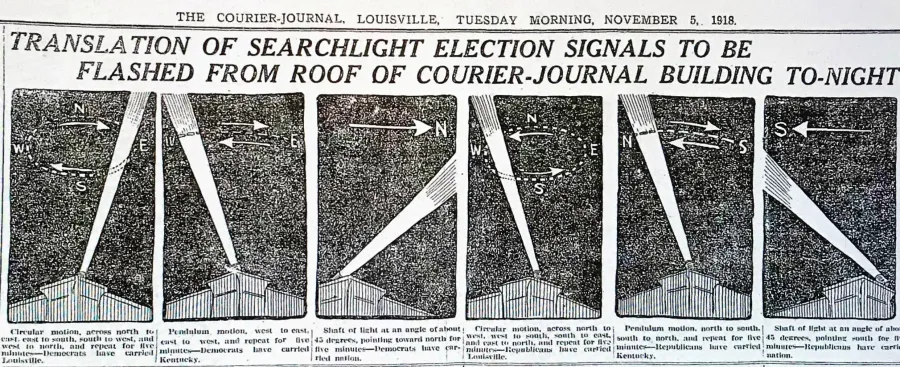Don't look to the stars for election returns in this pandemic

By BERRY CRAIG
AFT Local 1360
No matter how Kentucky votes on Nov. 3, the returns won't be written in the stars.
The results were the last time Kentuckians braved a deadly pandemic to cast ballots. The Spanish flu was raging on Nov. 3, 1918, when a Louisville Courier-Journal headline announced that the paper would report the Nov. 5 election results via a "5,000 Candle-Power Searchlight.”
Social distancing was in. Traditional campaigning was out nationwide, as the virus was killing thousands across the country and millions worldwide.
Customarily, election night throngs gathered at the Courier-Journal and Times building to watch the returns flashed on big white screens. They wouldn’t be erected "in accordance with the spirit and letter of the State Board of Health restrictions against crowds, indoors and out," the C-J explained on Nov. 2.
So the publishers of the sister papers, “realizing the keen disappointment that will come to Louisville’s election-night crowds” would employ the searchlight to signal voters who won, the Courier-Journal reported on Nov. 3.
“Many unusual features marked the campaign, which in many respects has no parallel in the state,” the paper added.
Never before—and not again until this year—did a health crisis so upend an American election.
Not all oddities were flu-related. In August, 1918, Sen. Ollie James of Marion, seeking a second term, died. (The Democrat succumbed to kidney disease, not the flu.)
Gov. A.O. Stanley of Henderson, also a Democrat, had his sights set on Washington. So he tossed his hat in the ring for James’ vacant seat.
“For the first time in the history of Kentucky, the Democrats have had a campaign without the time-honored spellbinding,” the paper explained. “The only speeches made were made by Gov. Stanley and [Democratic] Senator [John Crepps Wickliffe] Beckham, [of Bardstown] at Mayfield and Winchester before the ‘flu’ embargo went on.”
The C-J and Times had arranged to borrow “the immense searchlight” from R.V. Board, president of the Kentucky Wagon Manufacturing Co. The mighty beacon “has been used nightly since America entered…[World War I in 1917] in throwing a shaft of light around the big wagon works plant to detect enemy mischief,” the C-J explained. “Mr. Board will put on extra guards at night so that his property will be fully protected.”
The searchlight was hefted atop the Courier-Journal and Times Building at Third and Liberty. It was to be switched on “as fast as results are known.”
Newspaper readers were instructed in a “CODE OF SIGNALS.”
-- “Circular motion, across north to east, east to south, south to west, and west to north, and repeat for five minutes—Democrats have carried Louisville.”
-- “Circular motion, across north to west, west to south, south to east, and east to north, and repeat for five minutes--Republicans have carried Louisville.”
-- “Pendulum motion, west to east, east to west, and repeat for five minutes--Democrats have carried Kentucky.”
-- “Pendulum motion, north to south, south to north, and repeat for five minutes—Republicans have carried Kentucky.”
-- “Shaft of light at an angle of about 45 degrees, pointing toward north for five minutes—Democrats have carried nation.”
-- “Shaft of light at an angle of about 45 degrees, pointing south for five minutes—Republicans have carried nation.”
The Courier-Journal advised readers to clip out and save the code for election night. The C-J and the Times also promised extra editions with election returns. Too, the papers agreed to “answer a reasonable number of telephone requests for election results on Tuesday night.”
The searchlight flashed mixed signals: Stanley cruised past Republican Ben L. Bruner of Louisville. The Democrats dropped a congressional seat, but still held a hefty (8-3) majority in the state delegation.
The GOP won Louisville and wrested the U.S. House and Senate from the Democrats.